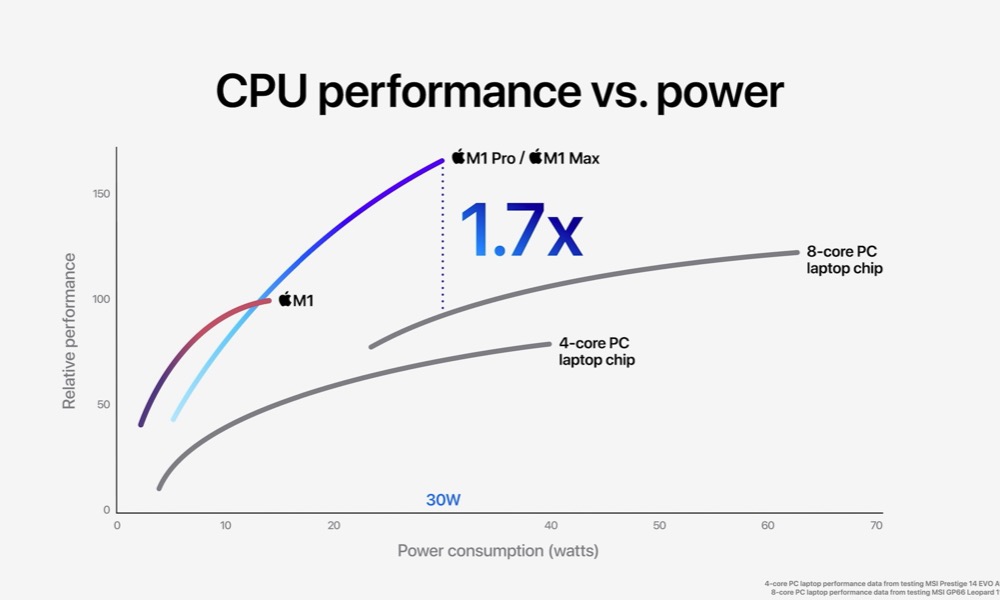Intel’s Alder Lake CPUs are Power Hungry Monsters Compared to the M1 Max
 Credit: Intel
Credit: Intel
Toggle Dark Mode
It shouldn’t come as a big surprise that Intel is pulling out all the stops to compete with Apple’s M1 chips. However, while the chipmaker may be able to eke out more raw performance from its latest desktop-class chips, its designs clearly still lack the elegance that Apple has brought to its own silicon.
Last week, Intel officially unveiled its 12th Gen Intel Core “Alder Lake” chips, headlined by the new Core i9-12900K, which it describes as “the world’s best gaming processor.”
This highest-end Core i9 chip actually packs in 16 cores, with eight performance cores and eight efficiency cores. That’s the same number of high-performance cores as Apple’s M1 Pro and M1 Max, with six additional high-efficiency cores.
It also looks like these extra cores make a difference, with the first Geekbench 5 benchmarks showing a 50% performance increase over the M1 Pro and M1 Max in multicore performance, both of which feature the same 10 CPU cores.
It’s worth mentioning that the Core i9-12900K is a desktop-class CPU, while the M1 Pro and M1 Max were designed exclusively for Apple’s new 14-inch and 16-inch MacBook Pro lineup. So, it’s not entirely a fair comparison. Further, these benchmarks are strictly about CPU performance, and therefore don’t factor in the GPU capabilities of the M1 Pro and M1 Max.
Intel still prefers to leave graphics performance to third-party GPU makers like Nvidia and AMD. So while the new Alder Lake chips do have integrated graphics capabilities, Apple’s M1 chips would likely run circles around them in this area.
Intel’s Performance Comes at a Cost
What’s significant about Intel’s performance gains in these latest chips is that even though they can claim multicore speeds that exceed those of Apple’s M1 Pro/Max chips, one thing that Intel hasn’t managed to achieve is making them power efficient in any way.
According to a detailed analysis by AnandTech, Intel’s 11th Gen CPUs already use 3–5 times more power than the M1 Max when running similar workloads. In fact, it looks like Intel is just willing to let its CPU suck in as much power as it needs.
Finally, stressing out both CPU and GPU at the same time, the [Intel] SoC goes up to 92W package power and 120W wall active power. That’s quite high, and we haven’t tested how long the machine is able to sustain such loads (it’s highly environment dependent), but it very much appears that the chip and platform don’t have any practical power limit, and just uses whatever it needs as long as temperatures are in check.
AnandTech
In other words, Intel may be able to create super-fast silicon, but it’s also doing so without any seeming concern for the amount of power that these chips will need to consume — and all that extra power may not really be worth it.
Looking at Intel’s newest 12th Gen i-912900K, ArsTechnica noted that it guzzles even more power than its predecessor, the 11900K, to gain the 50 percent performance increase that allows it to edge out the M1 Max.
We saw more than a 300W system power draw at the wall for the i9-12900K—that’s over 100 watts higher than our Ryzen 9 5950X at full tilt. About 230W of that draw is accounted for by the i9-12900K’s CPU package itself, as reported by its own sensors to hwinfo64. Power efficiency is a somewhat different story: although the i9-12900K guzzles more power than the i9-11900K did, it offers stunningly higher performance—about a 50 percent net gain.
ArsTechnica
Put simply, Intel’s Alder Lake CPUs are consuming up to five times more power than Apple’s M1 Max to achieve a mere 1.5X increase in performance.
There’s no doubt that Apple’s M1 Pro and Max chips are fast, but raw performance isn’t the only thing that Apple has to boast about. When it unveiled the very first M1 last year, Apple’s executives spent just as much time — if not more — talking about how little power the new M1 chip used. It repeated the same mantra last month with the M1 Pro and M1 Max.
With modern CPUs, it’s no longer about delivering the fastest raw performance numbers, and there are several reasons why lower power consumption is important:
- The first and most obvious are the environmental concerns. While higher CPU power consumption from a single computer may not be significant, millions of computers worldwide can make a pretty noticeable dent in the power grid.
- CPUs that require more power get hotter. That’s just the laws of physics at work, so there’s really no way to avoid it. Chips that consume less power can run sustained workloads for far longer without requiring sophisticated cooling systems, which of course, also require energy to run.
- Power-efficient CPUs are particularly important in laptops, where you may often find yourself running on battery. Apple was quick to point out that most Intel workstation-class laptops only provide maximum performance when they’re plugged in. Apple’s new MacBooks give you full performance even when running on battery — and still manage to provide outstanding battery life on top of that.
When Apple announced the new M1 chips last month, Johny Srouji, the company’s Senior VP of Hardware Technologies, candidly admitted that the M1 Max doesn’t offer any huge performance gains over top-end PC laptops with discrete GPUs. However, what’s important is that they can provide the same performance with 70% less power, which means less heat, less fan noise, and the ability to use all that performance even when running on battery.







